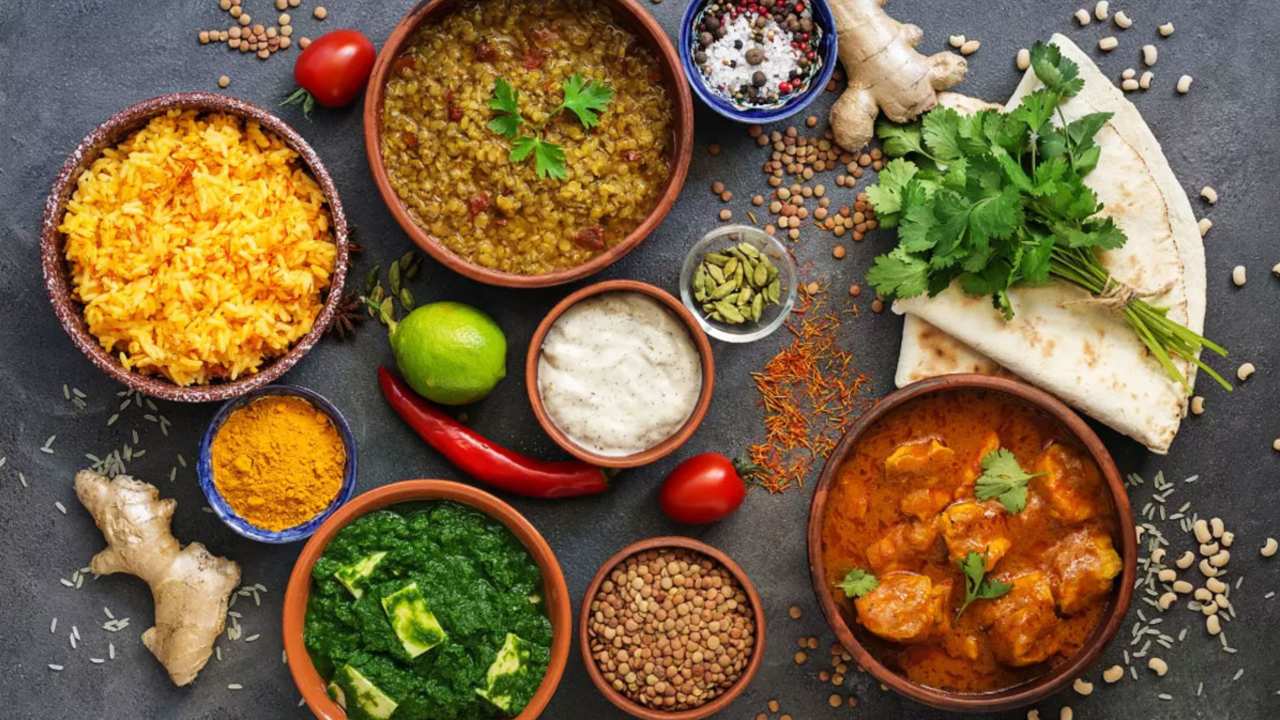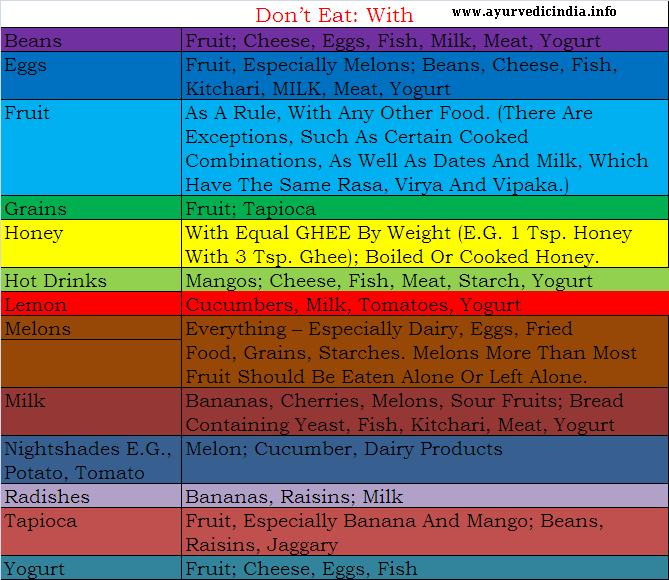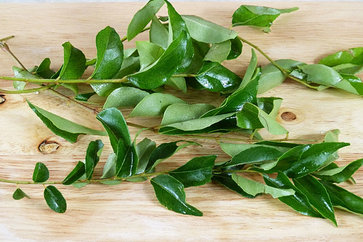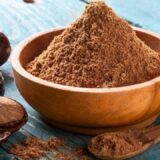Incompatible Foods in Ayurveda: What They Are & What to Eat
The concept of food combining has gained increasing awareness in recent years. While it became more widely known in the 1800s, Ayurveda, an ancient holistic science of healing, has recognized the importance of food combinations based on an individual’s constitution for over 5,000 years.
In recent years, food combinations have gained popularity among dietitians and weight-loss programs. It involves pairing foods with similar digestive requirements in a single meal, promoting better digestion and health. This approach, also known as trophology, advocates specific food combinations for optimal well-being.
In today’s world, people often eat a variety of foods that don’t digest well together, such as fruits with nuts or beans with cheese. These combinations can disrupt digestion and may lead to various health issues if not properly managed.
Ayurvedic View on Balanced Diet
The Ayurvedic perspective on a balanced diet emphasizes individual constitution, or Prakriti, which is based on the unique combination of the three doshas—Vata, Pitta, and Kapha—that govern both the mind and body. These doshas determine not only physical traits but also the emotional and mental makeup of an individual.
Key Concepts:
The Three Doshas:
- Vata: Represents air and ether; it governs movement, circulation, and the nervous system. People with a predominance of Vata may be quick, energetic, and creative.
- Pitta: Represents fire and water; it governs digestion, metabolism, and energy production. Pitta individuals tend to be assertive, intellectual, and sometimes intense.
- Kapha: Represents earth and water; it governs stability, structure, and nourishment. Kapha types are generally calm, stable, and grounded.
Digestive Fire (Agni):
- Ayurveda places great importance on the concept of Agni, or digestive fire. It’s believed that a strong Agni ensures proper digestion and assimilation of food, whereas a weak Agni leads to ama, or undigested food particles, which are considered toxins that can cause imbalances and diseases.
- The strength and quality of Agni vary based on one’s dosha and can also fluctuate depending on the time of day, seasons, and overall health.
Ama and Its Role in Imbalances:
- Ama is the toxic byproduct of improper digestion, and it can accumulate in the body, leading to various health issues. The presence of ama is a signal that there is a problem in the digestive system or that food is not being fully processed. Ayurvedic treatments often focus on strengthening Agni to prevent the formation of ama.
Personalized Nutrition:
A balanced diet in Ayurveda is tailored to an individual’s dosha type. For example:
- Vata: Vata types benefit from warm, moist, and grounding foods like soups, stews, and whole grains to balance their dry, light, and mobile nature.
- Pitta: Pitta types thrive on cooling, slightly bitter, and less spicy foods like salads, fruits, and dairy, as their fiery nature can become aggravated by heat.
- Kapha: To balance their heavy, moist, and stable qualities, Kapha individuals are encouraged to eat light, dry, and stimulating foods like spicy dishes, leafy greens, and legumes.
Ayurvedic View on Food Combining
In Ayurveda, the concept of food combining is deeply tied to the idea of Agni, or digestive fire. The principle behind this is that certain foods, when eaten together, can either harmonize or disrupt the body’s digestive processes, leading to health imbalances. The key to healthy digestion lies in understanding how different foods interact with each other and with our digestive system.
Key Concepts in Ayurvedic Food Combining:
1. Rasa (Taste): Every food has its own inherent taste, which falls under one of the six primary tastes in Ayurveda: sweet, sour, salty, bitter, pungent, and astringent. Each taste has its own impact on the body and mind, and when foods with different tastes are combined, it can either support or hinder the digestive process.
2. Virya (Energy/Temperature): Every food also has a heating or cooling quality. Some foods are considered heating (e.g., spicy foods, onions, garlic) and others are cooling (e.g., cucumbers, melons, dairy). When combining foods, it’s important to consider how their energies will affect the body’s Agni. Combining heating and cooling foods might disrupt the delicate balance of the digestive system, leading to indigestion or imbalanced Agni.
3. Vipaka (Post-Digestive Effect): After food is digested, it leaves a post-digestive effect on the body, which can be either sour, sweet, or pungent depending on the type of food consumed. This effect can influence how the body processes subsequent meals. If food with incompatible post-digestive effects is combined, it may overwhelm the digestive system.
4. Prabhava (Inexplicable Effect): Some foods have an unexplained or unique effect on the body (Prabhava). This can include the way they interact with digestion, mood, or energy levels. These subtle effects are often difficult to predict but are an important part of understanding food combinations.
The Role of Agni:
- Agni is the cornerstone of Ayurveda’s approach to digestion. It is believed that the strength of Agni determines how well food is digested and absorbed into the body. If Agni is strong, the body can process food efficiently, converting it into useful nutrients. If Agni is weak, however, food may not be digested properly, leading to the creation of ama (toxins), which can accumulate and cause disease.
Importance of Proper Food Combining:
- When foods are improperly combined—those with different tastes, energies, or post-digestive effects—it can overwhelm Agni. This can slow down digestion and hinder the enzyme systems that break down food.
- Bad combinations can lead to indigestion, fermentation, putrefaction, gas, and bloating. Over time, poor food combining can lead to toxemia, or the accumulation of toxins in the body, which disrupts the balance of the doshas and can result in various diseases.
Common Ayurvedic Guidelines for Food Combining:
- Avoid combining dairy and fruits: Fruits, especially sweet and sour ones, are considered fast-digesting, while dairy products are slow-digesting. When combined, this can slow down digestion, causing fermentation and the production of ama.
- Avoid mixing protein and starch: Proteins (e.g., meat, legumes) and starches (e.g., bread, rice) require different digestive enzymes and may confuse the digestive system when eaten together. This can lead to gas, bloating, and discomfort.
- Limit combining cold and hot foods: Cold foods (e.g., ice cream, cold drinks) and hot foods (e.g., spicy or fried foods) can create imbalance in the digestive system. Cold foods can slow down digestion, while hot foods may agitate the system, weakening Agni.
- Avoid combining sour foods with sweet or salty foods: Sour foods (like citrus or vinegar) can aggravate Pitta, and combining them with sweet or salty foods can further disrupt digestion.
- Fruits should be eaten separately: Fruits are best eaten on their own, ideally away from other foods, as they digest quickly and do not pair well with slower-digesting foods.
Benefits of Proper Food Combining:
- Proper food combining supports strong Agni, ensuring efficient digestion and absorption of nutrients.
- It prevents the formation of ama, reducing the risk of toxins accumulating in the body.
- It promotes better overall health by keeping the digestive system in balance, preventing indigestion and discomfort.
- When done correctly, food combining can help boost energy levels, enhance metabolism, and maintain emotional balance.
Ayurvedic View on Incompatible Food Combinations
In Ayurveda, food combinations that do not align with the body’s digestive capabilities can lead to digestive disturbances, the formation of ama (toxins), and ultimately the development of various diseases. These imbalances occur because improper food combining confuses Agni (digestive fire) and disrupts the body’s natural intelligence.
Here are two examples of incompatible food combinations and their effects:
Bananas and Milk:
Bananas and milk both have a sweet taste and cooling energy, which seems like a harmonious combination at first glance. However, their post-digestive effects are vastly different: bananas have a bitter post-digestive effect, while milk is sweet after digestion.
This mismatch confuses the digestive system and weakens Agni, causing improper digestion. The body struggles to process these foods together, resulting in the formation of ama, or undigested food particles. This can lead to:
- Nasal congestion
- Cold-like symptoms
- Cough
- Allergies
Milk and Melons:
Milk and melons are both cooling foods, but they have very different effects on the body:
- Milk is considered laxative and diuretic, meaning it can encourage bowel movements and urination.
- Melons, on the other hand, require stomach acid for proper digestion.
When combined, melons can cause milk to curdle, leading to digestive issues. Since milk requires more time to digest and the stomach acid required to break down melons causes milk to “fruition” (curdling or separation), this combination can interfere with proper digestion. This often results in:
- Digestive discomfort
- Bloating
- Indigestion
The Impact on Digestive Intelligence:
- When incompatible foods are consumed together, the digestive system becomes confused, leading to poor digestion and a weakened immune response. This confusion affects the intelligence of the cells, which in turn impacts their ability to function properly.
- The result is not only physical discomfort but also the potential development of diseases over time as toxins build up and systemic imbalances take hold.
General Ayurvedic Guidelines for Food Combining:
Here are a few common Ayurvedic guidelines to help avoid such disturbances:
- Avoid mixing sweet fruits with dairy products: This combination can cause fermentation and hinder digestion.
- Don’t combine proteins with starchy foods (like beans and potatoes): These foods require different enzymes for digestion and can lead to fermentation.
- Fruits should be eaten alone: Since fruits digest quickly, combining them with other foods can slow down their digestive process and create toxins.
- Avoid mixing heating and cooling foods: Combining foods with opposing energies (such as hot spicy foods with cold dairy) can confuse digestion.
- Don’t combine milk with acidic foods: Milk curdles and ferments when mixed with acidic foods, which can upset the stomach.
Ayurveda Food Combining Chart

Ayurveda Food Combining- A Simple Basic Rules
- Do not eat protein and starch together: Our body requires an acid-base to digest protein and an alkaline base to digest starch. Proteins and starches combine well with vegetables and green leaves but non-starchy vegetables do not combine well together.
- Eat single fruits or with other fruits: Fruits must be eaten alone or with other fruits. If fruits are very sweet eat a handful of nuts after some time(approx ratio of 80% fruit, 20% nuts)As fruits digest quickly they are almost digested by the time nuts reach the stomach, and if they combine with each other it may rot and get ferment.
- Never eat melons with any other foods or fruits: As melons digest faster than all other foods they should never be consumed with any other food, even with any other fruits.
- Never eat acidic fruits with any other sub-acidic sweet fruits: Acidic fruits such as pineapple, grapefruit, and strawberries can be eaten with other sub-acidic fruits such as apples, peaches, and grapes. But one must remember not to mix with sub-acid sweet fruits such as bananas, dates, or raisins.
- Never eat fats and oils with fruits: Fats and oils combine well with everything (except fruit) they should be used in limited amounts because they are very caloric which may slow down digestion. Therefore, keep your heavy meal with fat early or allow your body at least 4-5 hours to digest a heavy meal before eating again.
- Never consume two meals in close intervals: Food must be consumed two hours after eating fruits, three hours after eating starches, and four hours after eating proteins.
How to Fix Incompatible Food Combinations
In Ayurveda, if you’ve inadvertently eaten incompatible foods, there are specific remedies and practices to restore balance to your digestive system and alleviate the negative effects. The key is to strengthen Agni (digestive fire) and reduce the buildup of ama (toxins) caused by poor food combinations. Here are some helpful tips and food choices that can aid in correcting food imbalances:
Remedies for Specific Food Combinations:
Protein and Starch Combination:
- Fix: Eat legumes (like lentils) the next time to support digestion. Legumes help break down proteins and starches more efficiently when eaten alone or with compatible foods.
Nuts with Fruit:
- Fix: If you’ve eaten nuts, pair them with acidic fruits such as pineapple or strawberries. The acidity of these fruits can help digest the fats in nuts more efficiently.
Dairy with Fruits:
- Fix: When eating dairy products, pair them with acidic fruits. The acidity can assist in digesting dairy, preventing it from becoming heavy or causing mucus buildup.
Overloading with Pasta:
- Fix: If you’ve eaten too much pasta, have an apple the next morning. Apples are light and aid in digestion, helping to clear excess starch from your system.
Too Much Protein:
- Fix: After consuming too much protein, eating papaya the following morning is helpful. Papaya contains the enzyme papain, which supports protein digestion and helps relieve any discomfort.
Too Much Sugar:
- Fix: If you’ve eaten too much sugar, consuming grapes the next morning can help reset your system. Grapes have a mild detoxifying effect and can aid in digestion.
Too Much Salt:
- Fix: If you’ve had too much salt, eating watermelon the next morning can help balance your system. Watermelon is hydrating and has a cooling effect, helping to flush out excess salt.
General Guidelines for Strengthening Digestion:
- Don’t Stress About the Rules: While these guidelines are helpful, Ayurveda also teaches that a healthy, fit body has a strong Agni, meaning it can usually handle food combinations that may not be ideal for everyone. The key is maintaining balance, rather than stressing over every meal.
- Exercise Regularly: Regular physical activity strengthens your digestive fire. Exercise improves circulation, increases metabolism, and supports digestion, making it easier to handle potentially incompatible foods.
- Pitta Constitutions: People with a Pitta constitution generally have a strong digestive fire. They tend to process food well and don’t need to worry as much about food combining as other dosha types.
The Importance of Maintaining Digestive Health:
- Neglecting your digestive capacity by regularly eating incompatible food combinations may lead to digestive issues over time.
- Repeated digestive upset can cause the accumulation of ama, or toxins, which may weaken the digestive system and lead to disease.
- A strong digestive fire allows you to process food properly, preventing toxins and imbalances from accumulating in the body.
Incompatible food combinations can weaken Agni and lead to various health issues, from minor digestive discomfort to more chronic conditions caused by toxin accumulation. Ayurveda encourages mindful food pairing to optimize digestion, strengthen Agni, and maintain balance in the body.


























Don’t burden your digestive system by eating too full.Ayurveda does not suggests over-eating it’s rule say take half-stomach solid food, fill a quarter with water and leave the rest free. This is best for proper digestion.